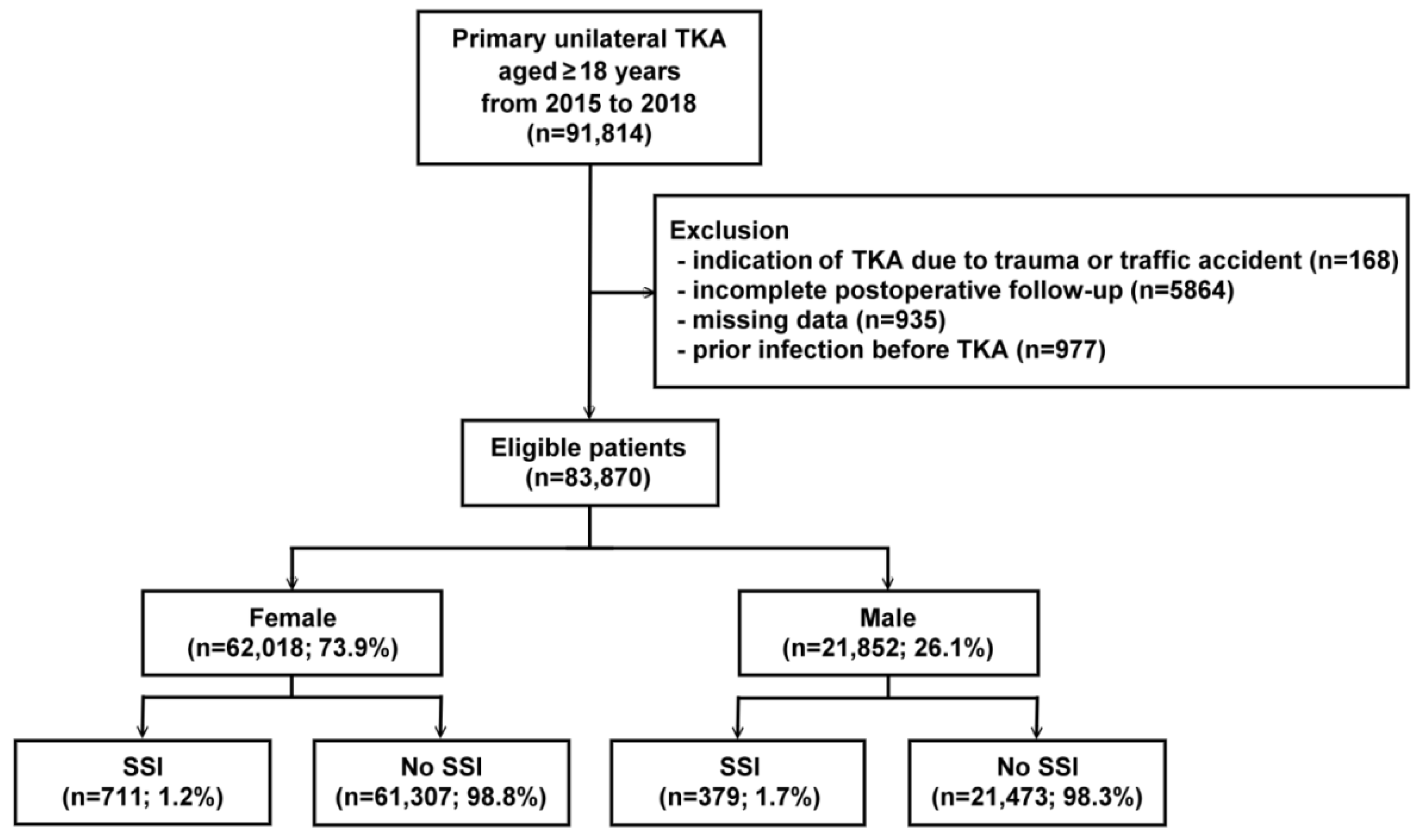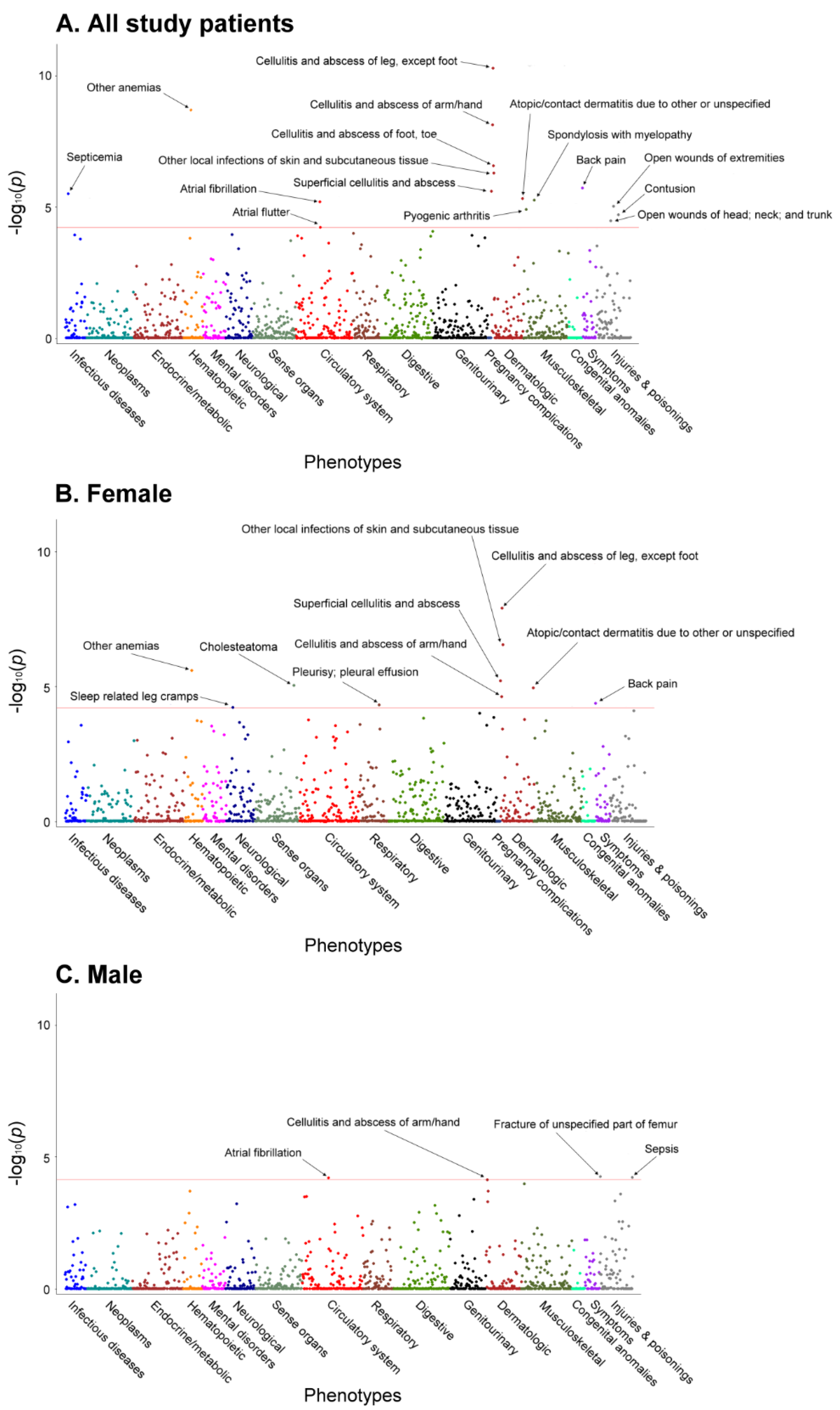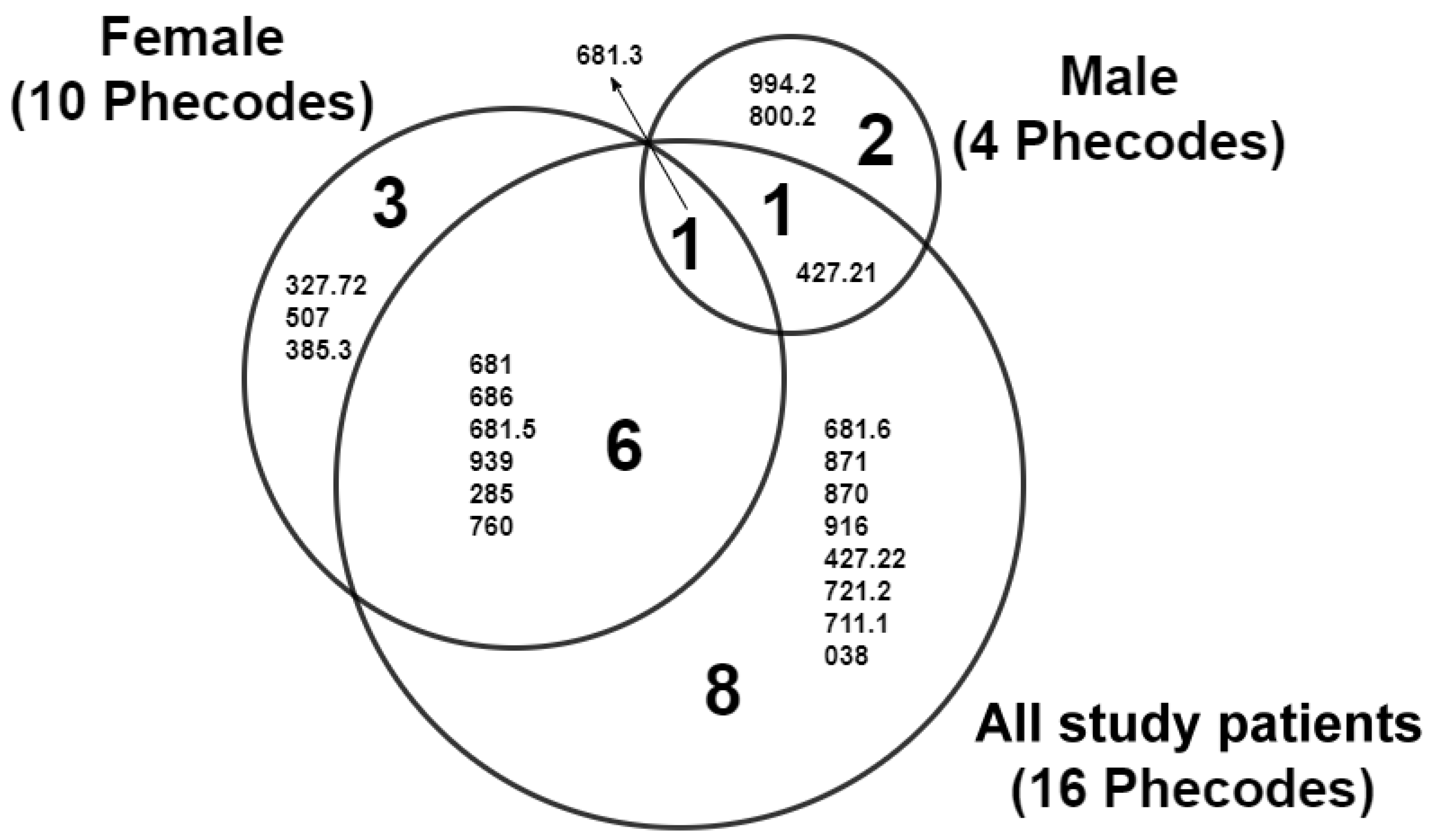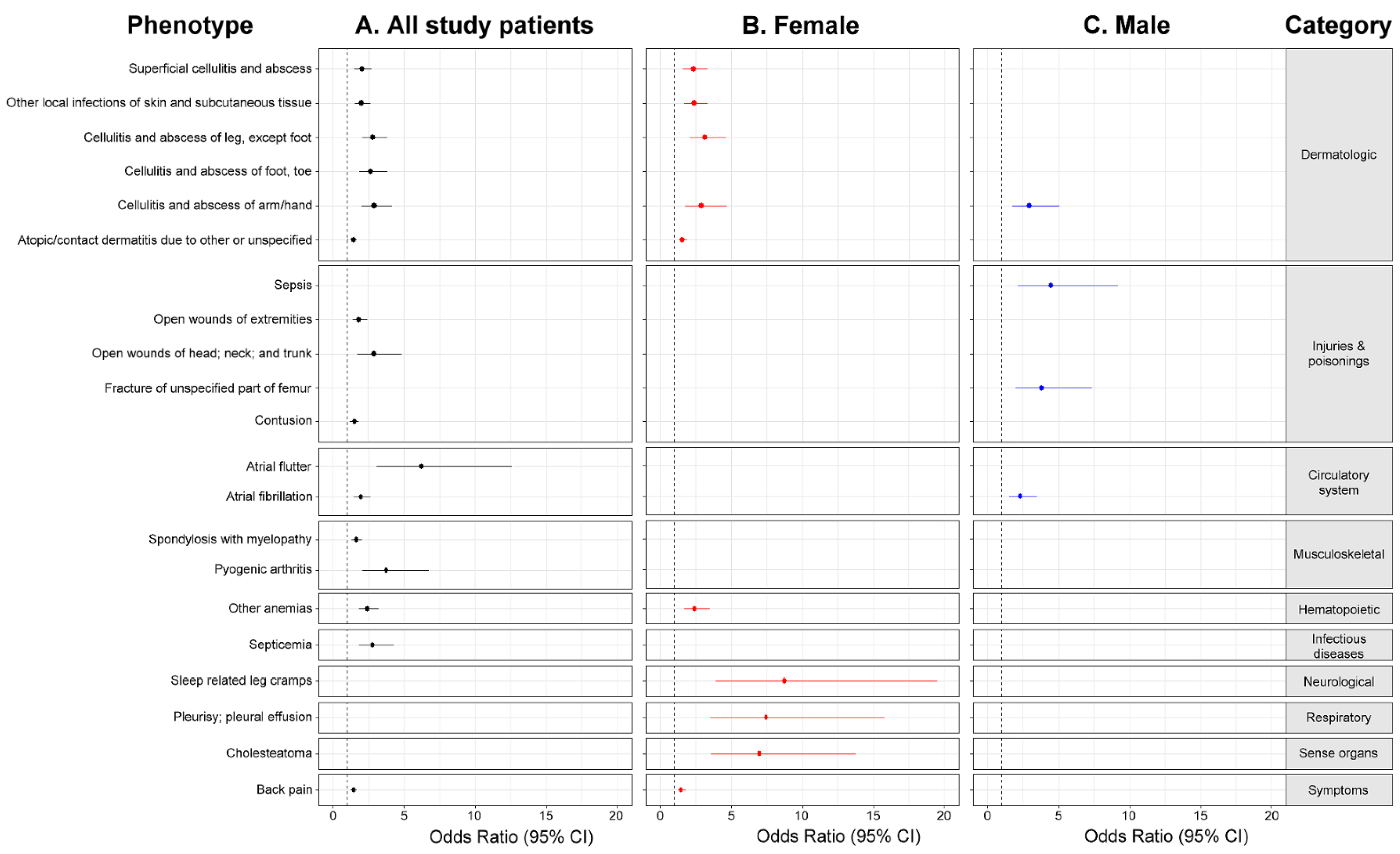Using the Phecode System to Identify the Preoperative Clinical Phenotypes Associated with Surgical Site Infection in Patients Undergoing Primary Total Knee Arthroplasty: The Sex Differences
Abstract
1. Introduction
2. Materials and Methods
2.1. Data Sources
2.2. Study Samples
2.3. Demographic Data and Primary Outcome
2.4. Phecodes for Evaluation of Preoperative Clinical Phenotypes
2.5. Statistical Analysis
3. Results
3.1. Characteristics of Participants
3.2. Associations between Preoperative Clinical Phenotypes and Postoperative Surgical Site Infection
3.3. Preoperative Clinical Phenotypes That Increased the Risk of Postoperative Surgical Site Infection
4. Discussion
5. Conclusions
Author Contributions
Funding
Institutional Review Board Statement
Informed Consent Statement
Data Availability Statement
Acknowledgments
Conflicts of Interest
References
- Sloan, M.; Premkumar, A.; Sheth, N.P. Projected volume of primary total joint arthroplasty in the U.S., 2014 to 2030. J. Bone Joint Surg. 2018, 100, 1455–1460. [Google Scholar] [CrossRef] [PubMed]
- Adeyemi, A.; Trueman, P. Economic burden of surgical site infections within the episode of care following joint replacement. J. Orthop. Surg. Res. 2019, 14, 1–9. [Google Scholar] [CrossRef] [PubMed]
- Solarino, G.; Maccagnano, G.; Saracino, M.; Moretti, B. An Unusual Complication after Infected Total Knee Arthroplasty. Joints 2018, 6, 241–245. [Google Scholar] [CrossRef] [PubMed]
- Edmiston, C.E., Jr.; Chitnis, A.S.; Lerner, J.; Folly, E.; Holy, C.E.; Leaper, D. Impact of patient comorbidities on surgical site infection within 90 days of primary and revision joint (hip and knee) replacement. Am. J. Infect. Control 2019, 47, 1225–1232. [Google Scholar] [CrossRef] [PubMed]
- Yang, G.; Zhu, Y.; Zhang, Y. Prognostic risk factors of surgical site infection after primary joint arthroplasty: A retrospective cohort study. Medicine 2020, 99, e19283. [Google Scholar] [CrossRef] [PubMed]
- Marusic, V.; Markovic-Denic, L.; Djuric, O.; Cirkovic, A.; Nikolic, V.; Dubljanin-Raspopovic, E.; Kadija, M. Incidence and risk factors of 30-day surgical site infection after primary total joint arthroplasty in a middle-income country: A single-center experience. Int. J. Environ. Res. Public Health 2021, 18, 863. [Google Scholar] [CrossRef] [PubMed]
- Antonelli, B.; Chen, A.F. Reducing the risk of infection after total joint arthroplasty: Preoperative optimization. Arthroplasty 2019, 1, 1–13. [Google Scholar] [CrossRef]
- Ratto, N.; Arrigoni, C.; Rosso, F.; Bruzzone, M.; Dettoni, F.; Bonasia, D.E.; Rossi, R. Total knee arthroplasty and infection: How surgeons can reduce the risks. EFFORT Open Rev. 2017, 1, 339–344. [Google Scholar] [CrossRef]
- Tayton, E.R.; Frampton, C.; Hooper, G.J.; Young, S.W. The impact of patient and surgical factors on the rate of infection after primary total knee arthroplasty: An analysis of 64,566 joints from the New Zealand Joint Registry. Bone Joint J. 2016, 98, 334–340. [Google Scholar] [CrossRef]
- Rhee, C.; Lethbridge, L.; Richardson, G.; Dunbar, M. Risk factors for infection, revision, death, blood transfusion and longer hospital stay 3 months and 1 year after primary total hip or knee arthroplasty. Can. J. Surg. 2018, 61, 165–176. [Google Scholar] [CrossRef]
- Brown, M.J.; Koh, N.P.; Bell, S.W.; Jones, B.; Blyth, M. Age and gender related differences in infection, thromboembolism, revision and death in knee arthroplasty in a Scottish population. Scott. Med. J. 2020, 65, 89–93. [Google Scholar] [CrossRef] [PubMed]
- Namba, R.S.; Inacio, M.C.; Paxton, E.W. Risk factors associated with deep surgical site infections after primary total knee arthroplasty: An analysis of 56,216 knees. J. Bone Joint Surg. 2013, 95, 775–782. [Google Scholar] [CrossRef] [PubMed]
- Bozic, K.J.; Lau, E.; Kurtz, S.; Ong, K.; Berry, D.J. Patient-related risk factors for postoperative mortality and periprosthetic joint infection in medicare patients undergoing TKA. Clin. Orthop. Relat. Res. 2012, 470, 130–137. [Google Scholar] [CrossRef] [PubMed]
- Chung, H.K.; Wen, S.H.; Chang, W.C.; Liu, K.L. Acute surgical site infection after total knee arthroplasty in patients with rheumatoid arthritis versus osteoarthritis. Sci. Rep. 2021, 11, 1–8. [Google Scholar] [CrossRef]
- Kao, F.C.; Hsu, Y.C.; Lai, P.Y.; Wang, C.B.; Tu, Y.K.; Chen, W.K. One-year mortality and periprosthetic infection rates after total knee arthroplasty in cancer patients: A population-based cohort study. BMC Cancer 2018, 18, 1–9. [Google Scholar] [CrossRef]
- Peersman, G.; Laskin, R.; Davis, J.; Peterson, M. Infection in total knee replacement: A retrospective review of 6489 total knee replacements. Clin. Orthop. Relat. Res. 2001, 392, 15–23. [Google Scholar] [CrossRef]
- Hasenauer, M.D.; Ho, H.; Engh, C.A., 3rd; Engh, C.A., Jr. Factors associated with the incidence and timing of total knee arthroplasty infection. J. Arthroplast. 2022, 37, S276–S280. [Google Scholar] [CrossRef]
- Wu, C.; Qu, X.; Liu, F.; Li, H.; Mao, Y.; Zhu, Z. Risk factors for periprosthetic joint infection after total hip arthroplasty and total knee arthroplasty in Chinese patients. PLoS ONE 2014, 9, e95300. [Google Scholar] [CrossRef]
- Corrao, S.; Argano, C.; Natoli, G.; Nobili, A.; Corazza, G.R.; Mannucci, P.M.; Perticone, F.; REPOSI Investigators. Sex-differences in the pattern of comorbidities, functional independence, and mortality in elderly inpatients: Evidence from the RePoSI register. J. Clin. Med. 2019, 8, 81. [Google Scholar] [CrossRef]
- Ahrenfeldt, L.J.; Möller, S.; Thinggaard, M.; Christensen, K.; Lindahl-Jacobsen, R. Sex differences in comorbidity and frailty in Europe. Int. J. Public Health 2019, 64, 1025–1036. [Google Scholar] [CrossRef]
- Gracia Gutiérrez, A.; Poblador-Plou, B.; Prados-Torres, A.; Ruiz Laiglesia, F.J.; Gimeno-Miguel, A. Sex differences in comorbidity, therapy, and health services’ use of heart failure in Spain: Evidence from real-world data. Int. J. Environ. Res. Public Health 2020, 17, 2136. [Google Scholar] [CrossRef] [PubMed]
- Denny, J.C.; Ritchie, M.D.; Basford, M.A.; Pulley, J.M.; Bastarache, L.; Brown-Gentry, K.; Wang, D.; Masys, D.R.; Roden, D.M.; Crawford, D.C. PheWAS: Demonstrating the feasibility of a phenome-wide scan to discover gene-disease associations. Bioinformatics 2010, 26, 1205–1210. [Google Scholar] [CrossRef] [PubMed]
- Denny, J.C.; Bastarache, L.; Roden, D.M. Phenome-Wide Association Studies as a Tool to Advance Precision Medicine. Annu. Rev. Genom. Hum. Genet. 2016, 17, 353–373. [Google Scholar] [CrossRef] [PubMed]
- Wu, P.; Gifford, A.; Meng, X.; Li, X.; Campbell, H.; Varley, T.; Zhao, J.; Carroll, R.; Bastarache, L.; Denny, J.C.; et al. Mapping ICD-10 and ICD-10-CM codes to phecodes: Workflow development and initial evaluation. JMIR Med. Inform. 2019, 7, e14325. [Google Scholar] [CrossRef]
- Wei, W.Q.; Bastarache, L.A.; Carroll, R.J.; Marlo, J.E.; Osterman, T.J.; Gamazon, E.R.; Cox, N.J.; Roden, D.M.; Denny, J.C. Evaluating phecodes, clinical classification software, and ICD-9-CM codes for phenome-wide association studies in the electronic health record. PLoS ONE 2017, 12, e0175508. [Google Scholar] [CrossRef]
- Sochacki, A.; Bejan, C.A.; Zhao, S.; Spaulding, T.; Stockton, S.; Silver, A.; Dorand, D.; Zhang, S.; Stricker, T.; Xu, Y.; et al. Patient specific comorbidities impact overall survival in myelofibrosis. Blood 2019, 134 (Supp. S1), 2959. [Google Scholar] [CrossRef]
- Song, R.J.; Ho, Y.L.; Schubert, P.; Park, Y.; Posner, D.; Lord, E.M.; Costa, L.; Gerlovin, H.; Kurgansky, K.E.; Anglin-Foote, T.; et al. Phenome-wide association of 1809 phenotypes and COVID-19 disease progression in the Veterans Health Administration Million Veteran Program. PLoS ONE 2021, 16, e0251651. [Google Scholar] [CrossRef]
- Zhang, T.; Goodman, M.; Zhu, F.; Healy, B.; Carruthers, R.; Chitnis, T.; Weiner, H.; Cai, T.; De Jager, P.; Tremlett, H.; et al. Phenome-wide examination of comorbidity burden and multiple sclerosis disease severity. Neurol. Neuroimmunol. Neuroinflamm. 2020, 7, e864. [Google Scholar] [CrossRef]
- Hsieh, C.Y.; Su, C.C.; Shao, S.C.; Sung, S.F.; Lin, S.J.; Yang, Y.H.K.; Lai, E.C.C. Taiwan’s National Health Insurance Research Database: Past and future. Clin. Epidemiol. 2019, 11, 349–358. [Google Scholar] [CrossRef]
- Lin, L.Y.; Warren-Gash, C.; Smeeth, L.; Chen, P.C. Data resource profile: The national health insurance research database (NHIRD). Epidemiol. Health 2018, 40, e2018062. [Google Scholar] [CrossRef]
- Lai, M.S. Developing Healthcare-Associated Infection Indicators Based on National Health Insurance Database and Other Administrative Data. Taiwan Centers for Disease Control. 2010. Available online: https://www.cdc.gov.tw/En/Professional/ProgramResultInfo/ppxd4Xu5zcYwcLHniXKk6w?programResultId=ptorY4NOs2mJ-loC76j60Q (accessed on 21 March 2022).
- Heinze, G.; Schemper, M. A solution to the problem of separation in logistic regression. Stat. Med. 2002, 21, 2409–2419. [Google Scholar] [CrossRef] [PubMed]
- Ahmad, M.A.; Ab Rahman, S.; Islam, M.A. Prevalence and risk of infection in patients with diabetes following primary total knee arthroplasty: A global systematic review and meta-analysis of 120,754 knees. J. Clin. Med. 2022, 11, 3752. [Google Scholar] [CrossRef] [PubMed]
- Klein, S.L.; Flanagan, K.L. Sex differences in immune responses. Nat. Rev. Immunol. 2016, 16, 626–638. [Google Scholar] [CrossRef]
- Ingersoll, M.A. Sex differences shape the response to infectious diseases. PLoS Pathog. 2017, 13, e1006688. [Google Scholar] [CrossRef] [PubMed]




| All | Female | Male | p-Value | |||
|---|---|---|---|---|---|---|
| Demographic characteristics | Sample size | 83,870 | 62,018 (73.9) | 21,852 (26.1) | ||
| Age (years) | 70.5 ± 8.4 | 70.4 ± 8.0 | 70.7 ± 9.4 | <0.001 | ||
| Surgical year of TKA | 0.067 | |||||
| 2015 | 21,904 (26.1) | 16,119 (26.0) | 5785 (26.5) | |||
| 2016 | 21,870 (26.1) | 16,229 (26.2) | 5641 (25.8) | |||
| 2017 | 22,764 (27.1) | 16,941 (27.3) | 5823 (26.6) | |||
| 2018 | 17,332 (20.7) | 12,729 (20.5) | 4603 (21.1) | |||
| Surgical site infection | 1090 (1.3) | 711 (1.2) | 379 (1.7) | <0.001 | ||
| Disease category | Phecode | Clinical phenotypes | ||||
| Dermatologic | ||||||
| 681 | a Superficial cellulitis and abscess | 1795 (2.3) | 1203 (2.1) | 592 (2.9) | <0.001 | |
| 686 | a Other local infections of skin and subcutaneous tissue | 2262 (2.8) | 1540 (2.6) | 722 (3.5) | <0.001 | |
| 681.5 | a Cellulitis and abscess of leg, except foot | 1339 (1.7) | 871 (1.5) | 468 (2.3) | <0.001 | |
| 681.6 | Cellulitis and abscess of foot, toe | 1046 (1.3) | 650 (1.1) | 396 (2.0) | <0.001 | |
| 681.3 | a,b Cellulitis and abscess of arm/hand | 1077 (1.4) | 686 (1.2) | 391 (1.9) | <0.001 | |
| 939 | a Atopic/contact dermatitis due to other or unspecified | 9985 (12.3) | 6949 (11.5) | 3036 (14.3) | <0.001 | |
| Injuries & poisonings | ||||||
| 994.2 | b Sepsis | 469 (0.6) | 324 (0.5) | 145 (0.7) | 0.019 | |
| 871 | Open wounds of extremities | 2352 (2.9) | 1468 (2.4) | 884 (4.2) | <0.001 | |
| 870 | Open wounds of head; neck; and trunk | 378 (0.5) | 232 (0.4) | 146 (0.7) | <0.001 | |
| 800.2 | b Fracture of unspecified part of femur | 652 (0.8) | 481 (0.8) | 171 (0.8) | 0.789 | |
| 916 | Contusion | 6240 (7.4) | 4665 (7.5) | 1575 (7.2) | 0.132 | |
| Circulatory system | ||||||
| 427.22 | Atrial flutter | 114 (0.1) | 62 (0.1) | 52 (0.3) | <0.001 | |
| 427.21 | b Atrial fibrillation | 1892 (2.4) | 1203 (2.1) | 689 (3.4) | <0.001 | |
| Musculoskeletal | ||||||
| 721.2 | Spondylosis with myelopathy | 4620 (7.3) | 3538 (7.6) | 1082 (6.3) | <0.001 | |
| 711.1 | Pyogenic arthritis | 287 (0.6) | 143 (0.4) | 144 (1.2) | <0.001 | |
| Hematopoietic | ||||||
| 285 | a Other anemias | 1635 (2.0) | 1152 (1.9) | 483 (2.2) | 0.001 | |
| Infectious diseases | ||||||
| 038 | Septicemia | 604 (0.7) | 398 (0.7) | 206 (1.0) | <0.001 | |
| Neurological | ||||||
| 327.72 | a Sleep-related leg cramps | 120 (0.2) | 89 (0.2) | 31 (0.2) | 0.844 | |
| Respiratory | ||||||
| 507 | a Pleurisy—pleural effusion | 180 (0.2) | 94 (0.2) | 86 (0.4) | <0.001 | |
| Sense organs | ||||||
| 385.3 | a Cholesteatoma | 134 (0.2) | 101 (0.2) | 33 (0.2) | 0.78 | |
| Symptoms | ||||||
| 760 | a Back pain | 11,702 (14.0) | 8874 (14.3) | 2828 (12.9) | <0.001 | |
| Disease Category | Clinical Phenotypes | All | Female | Male | ||||||
|---|---|---|---|---|---|---|---|---|---|---|
| No. of SSI | No. of Controls | OR | No. of SSI | No. of Controls | OR | No. of SSI | No. of Controls | OR | ||
| Dermatologic | ||||||||||
| a Superficial cellulitis and abscess | 992 | 77,977 | 2.05 * | 646 | 58,000 | 2.33 * | 346 | 19,977 | 1.66 | |
| a Other local infections of skin and subcutaneous tissue | 1001 | 78,435 | 2.01 * | 653 | 58,330 | 2.39 * | 348 | 20,105 | 1.51 | |
| a Cellulitis and abscess of leg, except foot | 989 | 77,524 | 2.81 * | 642 | 57,672 | 3.13 * | 347 | 19,852 | 2.43 | |
| Cellulitis and abscess of foot, toe | 975 | 77,245 | 2.65 * | 630 | 57,463 | 2.58 | 345 | 19,782 | 2.75 | |
| a,b Cellulitis and abscess of arm/hand | 977 | 77,274 | 2.91 * | 632 | 57,497 | 2.89 * | 345 | 19,777 | 2.95 * | |
| a Atopic/contact dermatitis due to other or unspecified | 1050 | 80,409 | 1.46 * | 684 | 59,549 | 1.57 * | 366 | 20,860 | 1.30 | |
| Injuries & poisonings | ||||||||||
| b Sepsis | 1090 | 82,766 | 2.32 | 711 | 61,300 | 1.02 | 379 | 21,466 | 4.44 * | |
| Open wounds of extremities | 1042 | 80,330 | 1.85 * | 692 | 59,767 | 1.86 | 350 | 20,563 | 1.86 | |
| Open wounds of head; neck; and trunk | 1001 | 78,397 | 2.93 * | 670 | 58,553 | 3.21 | 331 | 19,844 | 2.64 | |
| b Fracture of unspecified part of femur | 980 | 76,783 | 2.40 | 627 | 56,322 | 1.63 | 353 | 20,461 | 3.83 * | |
| Contusion | 1090 | 82,780 | 1.52 * | 711 | 61,307 | 1.60 | 379 | 21,473 | 1.37 | |
| Circulatory system | ||||||||||
| Atrial flutter | 991 | 75,263 | 6.22 * | 650 | 55,786 | 9.31 | 341 | 19,477 | 4.36 | |
| b Atrial fibrillation | 1032 | 77,000 | 1.96 * | 668 | 56,909 | 1.68 | 364 | 20,091 | 2.31 * | |
| Musculoskeletal | ||||||||||
| Spondylosis with myelopathy | 826 | 62,753 | 1.66 * | 525 | 45,767 | 1.66 | 301 | 16,986 | 1.68 | |
| Pyogenic arthritis | 677 | 44,779 | 3.74 * | 440 | 32,709 | 2.91 | 237 | 12,070 | 4.37 | |
| Hematopoietic | ||||||||||
| a Other anemias | 1068 | 81,501 | 2.43 * | 697 | 60,395 | 2.41 * | 371 | 21,106 | 2.46 | |
| Infectious diseases | ||||||||||
| Septicemia | 1065 | 80,896 | 2.79 * | 694 | 59,972 | 2.63 | 371 | 20,924 | 3.03 | |
| Neurological | ||||||||||
| a Sleep-related leg cramps | 913 | 70,136 | 6.49 | 577 | 51,257 | 8.72 * | 336 | 18,879 | 3.48 | |
| Respiratory | ||||||||||
| a Pleurisy; pleural effusion | 1080 | 82,305 | 3.91 | 705 | 61,057 | 7.44 * | 375 | 21,248 | 1.74 | |
| Sense organs | ||||||||||
| a Cholesteatoma | 1069 | 81,498 | 4.73 | 695 | 60,358 | 6.99 * | 374 | 21,140 | 0.74 | |
| Symptoms | ||||||||||
| a Back pain | 1090 | 82,780 | 1.45 * | 711 | 61,307 | 1.48 * | 379 | 21,473 | 1.40 | |
Publisher’s Note: MDPI stays neutral with regard to jurisdictional claims in published maps and institutional affiliations. |
© 2022 by the authors. Licensee MDPI, Basel, Switzerland. This article is an open access article distributed under the terms and conditions of the Creative Commons Attribution (CC BY) license (https://creativecommons.org/licenses/by/4.0/).
Share and Cite
Hung, T.-Y.; Liu, K.-L.; Wen, S.-H. Using the Phecode System to Identify the Preoperative Clinical Phenotypes Associated with Surgical Site Infection in Patients Undergoing Primary Total Knee Arthroplasty: The Sex Differences. J. Clin. Med. 2022, 11, 5784. https://doi.org/10.3390/jcm11195784
Hung T-Y, Liu K-L, Wen S-H. Using the Phecode System to Identify the Preoperative Clinical Phenotypes Associated with Surgical Site Infection in Patients Undergoing Primary Total Knee Arthroplasty: The Sex Differences. Journal of Clinical Medicine. 2022; 11(19):5784. https://doi.org/10.3390/jcm11195784
Chicago/Turabian StyleHung, Ting-Yu, Kuan-Lin Liu, and Shu-Hui Wen. 2022. "Using the Phecode System to Identify the Preoperative Clinical Phenotypes Associated with Surgical Site Infection in Patients Undergoing Primary Total Knee Arthroplasty: The Sex Differences" Journal of Clinical Medicine 11, no. 19: 5784. https://doi.org/10.3390/jcm11195784
APA StyleHung, T.-Y., Liu, K.-L., & Wen, S.-H. (2022). Using the Phecode System to Identify the Preoperative Clinical Phenotypes Associated with Surgical Site Infection in Patients Undergoing Primary Total Knee Arthroplasty: The Sex Differences. Journal of Clinical Medicine, 11(19), 5784. https://doi.org/10.3390/jcm11195784





